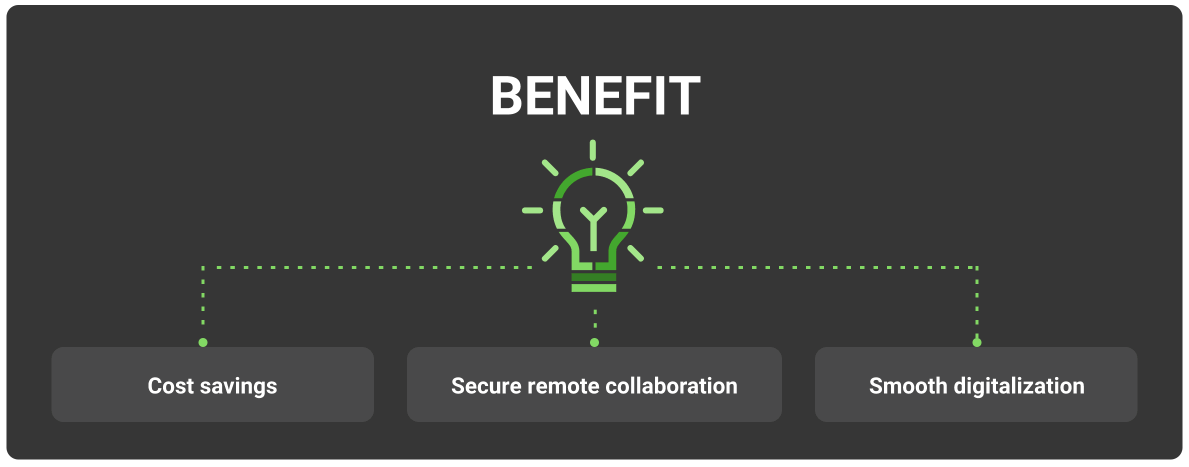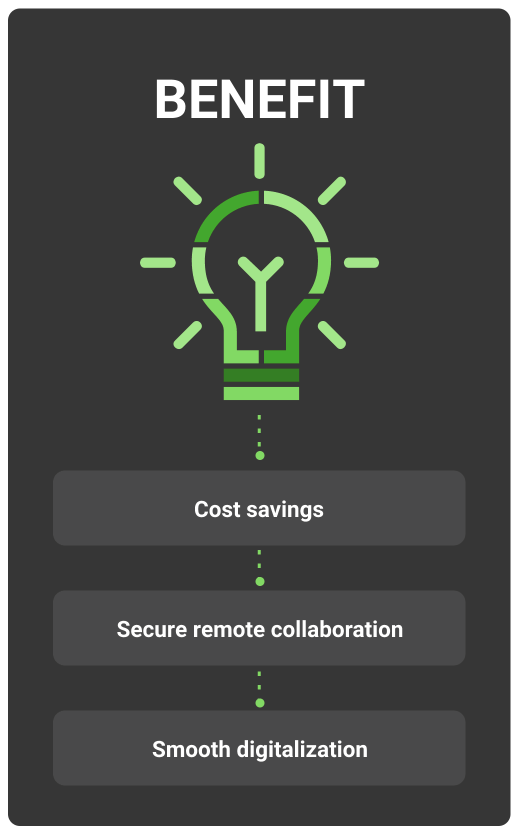According to Fundera, about 30% of companies in the United States outsource essential business functions, and 78% of them are happy with the results of such a choice. In turn, IT operations are among the top outsourced, especially for small and medium-sized businesses. Therefore, IT is rightfully considered one of the most successful outsourcing industries, the market size of which reached 92.5 billion in 2019. But 2020 has been marked by the outbreak of COVID-19, which turned the world upside down. How has this affected IT outsourcing? What problems have stakeholders face? What changes will help the industry enter the new era? We will discuss all these issues in this article.
Impact of COVID-19 on Outsourcing

The global pandemic has affected all sectors of the economy, including IT outsourcing. According to the Information Services Group, the annual contract value decreased by 5% from the previous year. It was caused by financial losses and the overall uncertainty at the beginning of the pandemic, forcing customers to abandon large investments and long-term obligations. Thus, it made it more difficult for IT vendors to sell their services in the face of widespread budget cuts.
Despite financial struggles, organizations increased their investments in digital solutions and as-a-service by 7%. In particular, IaaS spending has risen by almost 11% as the pandemic has proven the importance of maintaining a reliable infrastructure for remote collaboration from the very start. However, even such growth is hardly considered a success because it is the lowest in the last five years. The cost of annual contracts for SaaS, in turn, decreased by 2%. This decline would be even more critical if not for the demand for SaaS-based collaboration tools in the market.
IT Outsourcing and COVID-19 Challenges
COVID-19 has become a bolt from the blue in the global market. Its forced adjustments in the ordinary course of life, questioned the usual practices, changed the critical needs, and thereby marked the challenges that the outsourcing industry must quickly solve to embark on a recovery path.
Single-vendor issue. According to the Future of Sourcing, some projects were slowed down or stopped during the pandemic. One of the reasons was the poor preparation for remote work in some countries where a large number of outsourcing companies are concentrated. For example, in India, more than 50% of vendors reported a lack of technological resources to work from home. It made it challenging to provide services to customers and caused downtime. As a result, customers that worked only with one region and relied on a single vendor to implement several critical projects were hit the hardest.
Cybersecurity gaps. The global pandemic and, as a consequence, remote work has increased the demand for cloud communication and data storage services. Despite all the benefits, cloud environments can still be problematic if mismanaged. So even a simple misconfiguration can expose sensitive data to public access. Moreover, according to the Hiscox Cyber Readiness Report, 73% of organizations have confirmed their vulnerability to potential cyber-attacks. It can significantly complicate interaction with in-house staff and outsourcing partners, harm privacy policy, and lead to financial losses.
AI competition. COVID-19 has proven the vulnerability of human resources and businesses that depend entirely on them. Consequently, the need for process automation has become pressing for most industries and companies. GSA reports that today 53% of customers believe that the introduction of robotic process automation will significantly reduce the need for IT outsourcing.
Financial disputes. Neither customers nor the outsourcing companies could predict a pandemic and prepare for it. This raised a number of financial issues. Can the vendor be relieved of its contractual obligations in part or in full? Can the customer postpone or reduce payments due to financial difficulties? These questions did not have a single correct answer and, therefore, complicated the business relationship.
Shifting priorities. Previously, business owners saw IT vendors as a hired labor force, but now they want to turn them into strategic partners open to mutual investments and risk-sharing. With this approach, they want to reduce costs and risks by joint efforts and involve outsourcing partners in creating value and increasing their competitiveness. This imposes additional responsibility on IT vendors for the result.
KeyUA has 12+ years of successful market experience and an extensive base of steady customers. A result-oriented team of IT experts knows how to turn any of your ideas into a successful project.
Contact UsTop Outsourcing Trends post COVID-19
Coronavirus identified the weaknesses of seemingly streamlined and well-established processes and proved the need for changes. This has formed specific trends that will begin to gain momentum shortly. Now, the future of outsourcing post-COVID-19 depends on whether stakeholders can draw a lesson from this crisis and adapt to the new game rules.
1. Collaboration with Multiple Vendors
In the post-pandemic period, most organizations will not trust all critical functions to a single outsourcing partner. Instead, they will make individual contracts with several vendors from different geographic locations. With this approach, organizations will be able to hire expert outsourcing teams for various projects or tasks and get the best out of each one. Besides, it will significantly reduce the risks of downtime and project scrapping if one vendor cannot perform for some reason. In this case, other partners will be able to take over their functions partially or entirely.
2. Cybersecurity Demand

Due to cybersecurity gaps and vulnerabilities to cyber attacks, companies will increase spending on data protection and privacy, as well as access and identity management in the post-pandemic period. According to Forbes, global cybersecurity spending will amount to $131 billion in 2020 and reach $174 billion in 2022. At the same time, more than 50% of businesses will willingly outsource their cloud security management to prevent, identify, and respond to any potential risks promptly by experts.
3. Artificial Intelligence Implementation
There is an opinion that the boom in automation after COVID-19 can cause significant damage to IT outsourcing because AI may well replace some specialists' services. But this is only if IT vendors do not turn AI into their ally and can not use it to improve the quality of services provided.
You’re either the one that creates the automation, or you’re getting automated,
said Tom Preston-Werner, co-founder of the GitHub software development platform.
Therefore, IT vendors will strive to become the ones who create automation to meet the actual needs of customers after COVID-19. The implementation of AI can correct some of the outsourcing industry's weaknesses, such as slow response times or security risks, thereby improving the customer experience. Besides learning how to apply AI inventions, IT vendors can develop sought-after automated solutions and improve internal processes, thereby increasing competitiveness in the market.
4. Worst Case Scenario Planning
Understanding both parties' obligations in case of force majeure and the transparency of financial relations strengthen cooperation during crises. Therefore, after the pandemic, one of the main trends will be developing a worst-case action plan by the customer and the vendor, with its subsequent documentation in the outsourcing agreement. Both parties will also negotiate successful crisis interaction methods and emergency measures, such as duplicating connection channels, storing backups, and reserving technical infrastructure.
5. Changing the Сooperation Terms
Global Sourcing Association announces that client companies will enter into not time-and-material but result-based contracts with IT vendors. According to GSA reports, 69% of respondents predict that IT outsourcing companies will become system integrators. This kind of result-oriented collaboration will have benefits for both parties. IT outsourcing companies can count on long-term partnership and stable investment from the customer. In turn, customers receive reliable technical support, increased quality of services provided to end-users, and innovative solutions that add competitiveness to their companies in the market.
KeyUA is a reliable provider of custom solutions for your business. Our team of professional software developers is responsive to your goals and proactive in achieving them.
Contact UsIT outsourcing post-COVID-19: What's the Benefit?


According to market research company Technavio, the IT outsourcing market will grow by $98 billion from 2020 to 2024, with a CAGR of about 5%. The main reason for such a positive outlook is the urgent need for companies in different industries to optimize business processes and introduce innovative solutions into their daily activities. In turn, IT vendors can meet these pressing needs, thereby helping companies stay afloat during the crisis and mitigate external factors' impact. Besides, the IT outsourcing growth during and after the pandemic has other reasons.
1. Cost savings. During the coronavirus pandemic, declining revenues and cutting budgets have become challenges for companies around the world. Even with declining incidence rates, a full financial recovery can take years. Therefore, any savings are appreciated more than ever. This underlines the relevance of IT outsourcing during COVID-19 and in the post-pandemic period.
By hiring onshore, nearshore, or offshore companies, business owners save significant amounts of money on recruiting staff, training employees, and maintaining equipment and software. Besides, today IT providers compete for customers by offering beneficial prices, flexible collaboration options, budgeting assistance, and transparent financial reporting.
2. Secure remote collaboration. Gartner survey found that more than 80% of employees from over 50% of companies worldwide have switched to remote work due to coronavirus. This forced transition made the task of CEOs more difficult. Some of them do not have a strategy to manage a remote team's productivity and efficiency, proper network security tools, or just the ability to provide all employees with the necessary software at home.
For IT outsourcing providers, remote development is commonplace. Therefore, they can help customers to ensure scalability, security, and reliability of the company’s infrastructure and offer them custom communication tools to keep staff productive at home. Since work from home becomes the new norm, IT outsourcing after COVID-19 can help companies adopt it with minimum losses.
3. Smooth digitalization. The forced restrictions associated with the pandemic have increased consumer demand for online shopping and digital payments. It caused the need to digitize businesses in different industries since the online format is one of the proven ways to keep in touch with consumers. Companies that cannot adapt to new market conditions lose their competitiveness and profit, respectively. Given that there are no accurate predictions about the end of the pandemic, this trend will remain unchanged for at least 2021.
Unlike companies used to offline operations and traditional business models, outsourcing software teams quickly adapt to the latest changes and innovations and develop relevant solutions. Partnering with them will enable business leaders to drive digital transformation swiftly and smoothly. Besides, the need for maintaining and growing an online business can turn outsourced tech teams into useful strategic partners in the future.
Conclusion
COVID-19 took all the industries by surprise, and outsourcing was no exception. The challenges faced by IT vendors and customers raised tough questions, pushed them out of their comfort zone, and forced them to make radical decisions to adapt to a new environment. Despite all the difficulties, such a shake-up gave rise to recent trends and determined the industry's development trajectory for the coming years. It means that both customers and IT vendors are ready to make the most of this negative experience, lay the foundation for future productive cooperation, and bring the industry to a new level. Given the optimistic forecasts for the outsourcing market development, they are on a hot streak.
Transparent and reliable cooperation is the key to success, even in challenging times. KeyUA IT experts not only develop custom solutions but also guarantee their efficiency for your business.
Contact Us







 UA, Kyiv, Business Centre Gulliver
UA, Kyiv, Business Centre Gulliver

Comments
Leave a comment